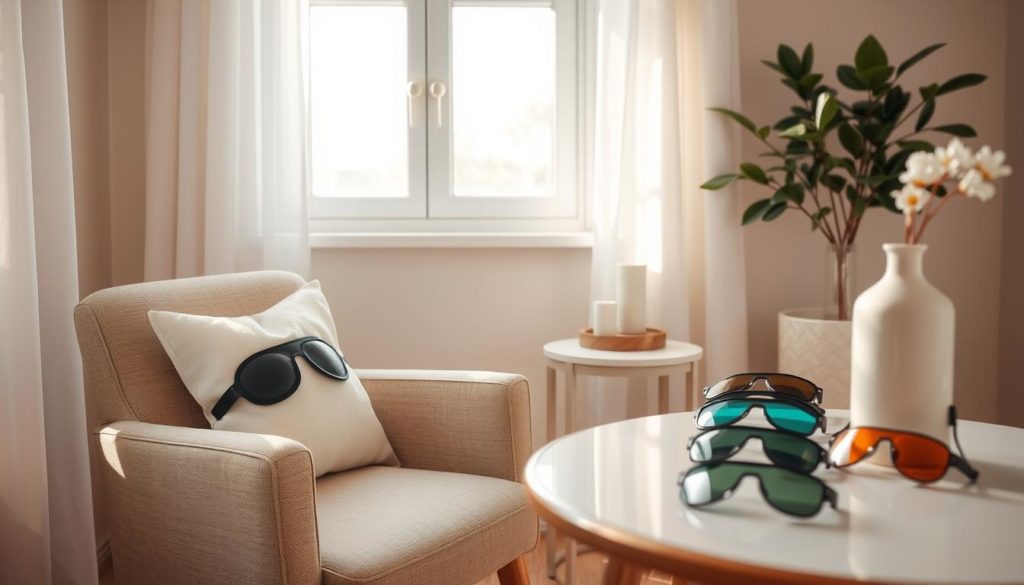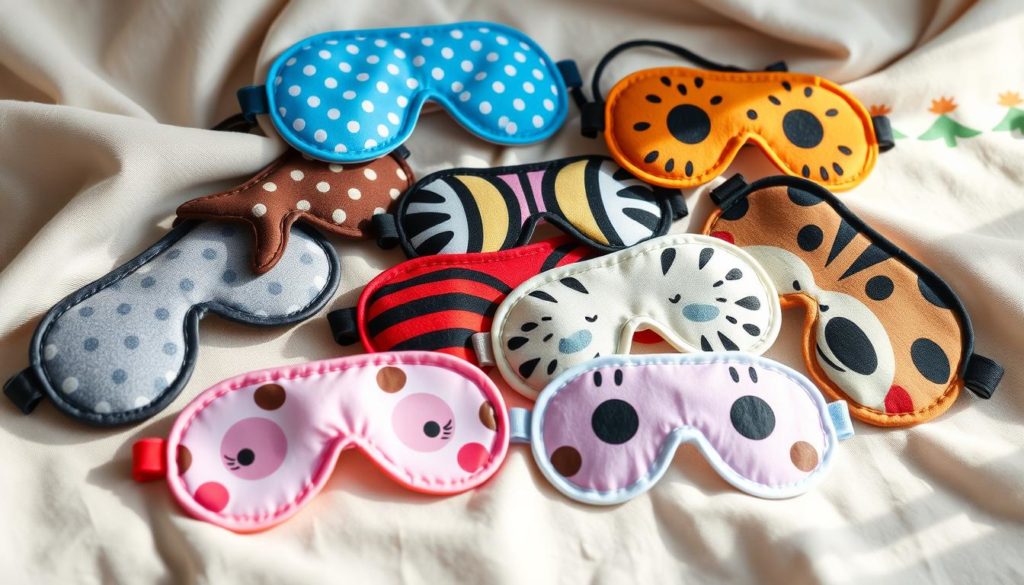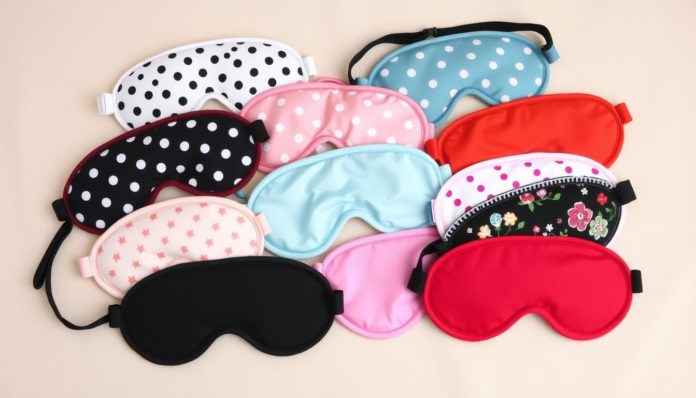Did you know over 5% of American kids have amblyopia, or “lazy eye”? This shows how important good treatments are. Eye patches are a top choice for non-invasive help. They’re great for kids and adults with vision issues like strabismus or diplopia.
Eye patches are key for kids and adults with eye problems. They’re flexible and help with many conditions. The right eye patch can greatly improve vision and eye health.
This guide will help you find the best eye patch for you. We’ll look at options that improve vision and eye health. Stay with us to learn more.
Introduction to Eye Patches for Vision Problems
Eye patches have changed a lot over time. They used to be just simple fabric. Now, they are advanced tools for vision correction. They help treat many vision problems.

Eye patches help with issues like amblyopia (lazy eye) and strabismus (crossed eyes). They cover the strong eye. This makes the weak eye work harder. It helps the brain learn to see better together.
Today, eye patches are made for different needs. They can be used for a short time or for a long time. There are many types, like soft fabric and adhesive ones. They are made to be comfortable and work well.
Eye patches are a big part of vision therapy. They show how useful and important they are. We will learn more about them soon.
Understanding Vision Therapy Eye Patches
Vision therapy eye patches are new tools for treating eye problems. They are given by optometrists to help improve vision. These patches are part of a special therapy program.

What Are Vision Therapy Eye Patches?
Vision therapy eye patches are special patches for eye treatments. They help improve how well both eyes work together. This is great for people with lazy eye or crossed eyes.
How Vision Therapy Eye Patches Work
These patches work by covering the stronger eye. This makes the weaker eye do more work. It helps the brain learn to use both eyes better.
Studies show that these patches really help improve how well eyes work together. They are part of a bigger vision therapy program.
Benefits of Using Amblyopia Eye Patches
Amblyopia eye patches have many benefits for eyesight and treating lazy eye. They help the weaker eye get stronger. This makes vision better and more balanced between both eyes.
One big plus of these patches is they improve depth perception. When the stronger eye is covered, the brain uses the weaker eye more. This can greatly improve how well you see.
Many people have seen big improvements in their vision. For example, a mom said her child’s vision got much better in just a few months. Studies also show that eye patches really help improve vision.
| Benefit | Description |
|---|---|
| Enhanced Visual Acuity | Regular use leads to sharper, clearer vision. |
| Improved Depth Perception | Balanced using both eyes, creating a more natural 3D vision experience. |
| Preventing Dominance | Helps in preventing the strong eye from becoming overly dominant. |
Amblyopia eye patches are key in treating lazy eye. They are a safe and easy way to improve eyesight. Using these patches daily can lead to better vision and a more balanced way of seeing.
Types of Lazy Eye Patches Available
When looking at eye patch options, two types are often chosen: fabric and adhesive lazy eye patches. Each has its own benefits, fitting different needs and skin types. Let’s dive into what makes each one special:
Fabric Lazy Eye Patches
Fabric lazy eye patches are known for being comfy and reusable. They’re made from soft, breathable materials that are kind to sensitive skin. This makes them a great pick for those with delicate skin.
They’re also good for the planet because you can wash and reuse them. This means they last longer and work well over time.
Adhesive Lazy Eye Patches
Adhesive lazy eye patches are perfect for people who are always on the move. They stick to your skin, keeping them in place. This is great for anyone who needs a patch that won’t budge.
They come in many sizes and designs, so you can find one that fits your style. Even though you can only use them once, the convenience of a secure fit is a big plus.
| Patch Type | Material | Key Benefits | Best For |
|---|---|---|---|
| Fabric Lazy Eye Patches | Soft, breathable fabrics | Comfort, reusability | Sensitive skin, eco-conscious individuals |
| Adhesive Lazy Eye Patches | Skin-safe adhesives | Firm positioning, varied sizes | Active users, those needing secure fit |
Both fabric and adhesive patches have their own perks. This means you can pick the best one for you based on your needs and likes. Knowing what each offers helps you make a smart choice for your eye care.
Strabismus Eye Patches: What You Need to Know
Strabismus, or cross-eyed condition, affects many children and adults. Eye patches are a key treatment to correct this issue.
Eye patches cover the stronger eye. This makes the weaker eye work harder. Over time, it gets stronger and more coordinated. Eye care professionals create a patching schedule for each person.
Eye patches are often used with other treatments. Glasses or surgery might be suggested too. A complete treatment plan can greatly improve eye alignment and vision.
| Treatment Method | Role in Eye Alignment |
|---|---|
| Strabismus Eye Patches | Enhances the function of the weaker eye, encouraging balanced eye alignment |
| Corrective Glasses | Helps to correct refractive errors, improving overall vision and eye coordination |
| Surgical Procedures | Aligns the eye muscles for immediate correction of severe misalignment |
Using different treatments together is a strong approach to manage strabismus. The patching schedule depends on the strabismus’s severity and the person’s age. Following professional advice is key to the best results.
Choosing an Eye Patch for Children
Choosing the right eye patch for your child is key. It must be comfortable and effective. Let’s look at important factors for picking an eye patch that supports your child’s eye health.
Kid-Friendly Designs
Eye patches that are fun and colorful are more likely to be worn. Look for patches with bright colors, fun patterns, or favorite characters. These can make wearing the patch a positive experience for your child.
Ensuring Comfort and Safety
Comfort and safety are top priorities when picking an eye patch. Make sure it’s made from hypoallergenic, soft materials. Also, it should breathe well to prevent discomfort when worn for a long time. Here’s a comparison to help you decide:
| Feature | Fabric Patches | Adhesive Patches |
|---|---|---|
| Material Comfort | Soft and breathable | Can be hypoallergenic but may cause irritation |
| Security | Adjustable straps for a secure fit | Adheres directly to the skin |
| Ease of Use | Reusable and washable | Disposable after use |
Talking to a pediatric optometrist can give you more advice. They can help you find an eye patch that’s both comfortable and appealing to your child. This way, your child’s eye health journey can be both successful and fun.
Best Eye Patch Options for Adults
Choosing the right eye patch is key for adult eye care. It must be both comfortable and effective. There are many options that look good and help your vision. Here are some top picks:
Sleek Designs: Today’s eye patches come in cool designs. They fit right into your everyday look. These designs are not just for looks; they also work well.
Material Quality: It’s important to use high-quality materials. Look for soft, breathable fabrics and ones without latex. Many have padded interiors for extra comfort.
Adjustable Straps: Eye patches with adjustable straps are a great choice. They fit snugly on different head sizes and shapes. This makes the patch more comfortable and effective.
Recommendations: Doctors and patients often suggest certain brands. Ortopad and MYI Occlusion Patches are favorites. They’re known for being comfy, stylish, and effective.
| Brand | Main Features | Reviews |
|---|---|---|
| Ortopad | Padded interior, breathable material | Highly recommended by ophthalmologists |
| MYI Occlusion Patches | Adjustable straps, stylish designs | Popular among adult patients |
Eye Patch Solutions for Diplopia
Eye patches can help treat double vision. They can be used temporarily or for a long time. It’s important to choose the right option based on your needs and lifestyle.
Temporary Use vs. Long-term Use
For short-term relief, eye patches are a good choice. They work well for occasional double vision or when focusing on tasks. But, for long-term or severe cases, they might be needed all the time.
Wearing an eye patch daily can help manage double vision. It makes daily activities easier and keeps you productive.
“Opting for long-term use of an eye patch was life-changing. It allowed me to carry on with my job without facing constant double vision issues,” shares Thomas, a patient with chronic diplopia.
Customizable Options
Custom eye patches are key for treating double vision. They should fit comfortably with your glasses and meet your specific needs. Some patches have adjustable straps for a secure fit, while others are made of breathable materials for comfort.
Choosing a patch that’s both comfortable and functional is important. This way, you can easily incorporate it into your daily routine.
- Adjustable Straps: Ensures the eye patch remains secure throughout the day.
- Breathable Materials: Helps in reducing discomfort during prolonged use.
- Custom Shapes and Sizes: Caters to individual preferences and needs.
Eye Patches for Crossed Eyes
Eye patches are key in treating crossed eyes or strabismus. They cover the stronger eye, letting the weaker eye get stronger. This can fix eye crossing over time. Optometrists often guide this therapy.
Eye patches work well with binocular vision therapy. This therapy trains the brain and eyes to work together. It improves visual coordination. This method helps fix eye alignment and keeps it stable long-term.
Studies show eye patches help in therapy. They train eye muscles and nerves to align. This is a non-invasive, affordable, and practical treatment.
| Therapeutic Approach | Benefits | Considerations |
|---|---|---|
| Eye Patching | Strengthens weaker eye, corrects eye crossing, cost-effective | Requires consistent use, possible discomfort |
| Binocular Vision Therapy | Improves overall visual coordination, long-term benefits | Needs specialized guidance, time-intensive |
| Combination Therapy | Maximizes benefits of both methods, holistic | Requires dedication and commitment |
Eye patches are part of a complete treatment plan. They boost the effect of binocular vision therapy. This helps fix eye crossing in people with strabismus.
How to Properly Use an Eye Patch
Using an eye patch correctly is key to treating vision problems. It helps with amblyopia, strabismus, and diplopia. Knowing the right steps and avoiding mistakes is important for comfort and effectiveness.
Step-by-Step Guide
Here’s a detailed guide for using an eye patch correctly:
- Choose the appropriate eye patch: Pick a patch that fits well and is comfy. Ortopad and Nexcare Opticlude are good choices.
- Prepare the skin: Clean and dry the skin around your eye. Don’t use lotions or creams that might make the patch fall off.
- Proper placement: Place the patch over your eye, making sure it covers the whole area without blocking your eyelashes.
- Smooth application: Press the patch firmly and smooth out any wrinkles to keep it in place.
- Adherence to schedule: Stick to the patching schedule your optometrist gave you. Consistency is crucial for success.
Common Mistakes to Avoid
Even with good intentions, mistakes in using eye patches can slow progress. Here are common errors and how to avoid them:
- Inconsistent use: Skipping days or using it irregularly can slow down improvement. Stay on schedule.
- Poor fit: A patch that’s too tight or too loose can be uncomfortable or irritate your skin.
- Incorrect positioning: Make sure the patch is centered. Off-center placement reduces effectiveness.
- Ignoring skin care: Not taking care of your skin can cause rashes or irritation. Always start with clean, dry skin.
By following these tips, you can use eye patches correctly. This will help manage your vision condition effectively.
Where to Buy Eye Patches for Vision Problems
Finding the right eye patch can seem hard. It’s key to look at both online and local places. This makes buying easier.
Online Retailers
Online stores are great for finding eye patches. Sites like Amazon and Walmart have lots of options. You can find fabric or adhesive patches.
Stores like Walgreens and CVS have filters and reviews. These help you pick the right eye patch.
When buying online, check the seller’s return policy and customer service. Good sellers have clear product info and lots of feedback. This helps you choose well.
Local Stores
Shopping in stores is also good. Places like Target and Rite Aid have eye patches. Specialized stores or pharmacies offer more help.
Shopping in person lets you see products before buying. You can find the best fit and comfort. Plus, in-store advice can be very helpful.
Using both online and local stores increases your chances of finding the right eye patch.
User Reviews and Recommendations
Looking at how different eye patches work in real life helps us make better choices. By checking out what others say and how well these patches work, we find some common themes.
“I’ve been using the AmblyoPatch for about a month, and the comfort level is fantastic. It’s also quite effective for my vision therapy,” shares a satisfied user on Amazon.
The Ortopad Elite is another favorite, known for its great design and comfort, especially for kids:
- Comfort: Many parents said their kids didn’t get irritated when wearing these patches.
- Effectiveness: People said they saw big improvements in amblyopia in just a few weeks.
Here’s a table that shows the main points from what customers have said and how well these patches work:
| Brand | Comfort | Effectiveness | Design Preference |
|---|---|---|---|
| AmblyoPatch | High | Excellent | Neutral colors and smooth texture |
| Ortopad Elite | Very High | Outstanding | Kid-friendly designs |
| Nexcare Opticlude | Moderate | Good | Simple, versatile appearance |
Looking at what people say helps us pick the right eye patch. Comfort and how well they work are key. Design matters too, especially for kids.
Conclusion: Finding the Best Eye Patch for Your Needs
Choosing the right eye patch is key for good eye care. There are many types, like those for amblyopia and strabismus. You can find options for kids and adults too. Pick one that fits your vision issues, comfort, and lifestyle.
Start by learning about each eye patch’s use and benefits. Fabric patches are comfy and breathable for daily use. Adhesive patches are handy and effective. Knowing the difference between temporary and long-term solutions is also important.
Always ask your eye doctor for advice before buying. They know what’s best for your eyes. Making a smart choice helps your health and improves your life. Start your eye care journey with confidence and knowledge.
FAQ
What Are Vision Therapy Eye Patches?
Vision therapy eye patches are medical tools for sight problems. Optometrists prescribe them to improve vision skills. They cover the stronger eye to help the weaker one, enhancing vision and brain flexibility.
How Do Vision Therapy Eye Patches Work?
These patches cover the stronger eye, making the weaker eye work harder. This boosts visual clarity and depth perception. Studies show they improve vision significantly with regular use.
What Are the Benefits of Using Amblyopia Eye Patches?
Amblyopia patches enhance vision and depth perception. They prevent the stronger eye from dominating. Research proves they balance eye use and improve eye health.
What Types of Lazy Eye Patches Are Available?
There are fabric and adhesive lazy eye patches. Fabric patches are reusable and comfy for long wear. Adhesive patches fit tightly and come in various sizes. Choose based on comfort and need.
How Do Strabismus Eye Patches Help in Correcting Eye Alignment?
Strabismus patches cover the aligned eye, making the misaligned one work harder. They’re used with glasses or surgery, following doctor’s advice.
What Should I Consider When Choosing an Eye Patch for My Child?
Choose a patch that’s comfy, safe, and appealing to kids. Look for hypoallergenic, kid-themed patches made from soft materials. This makes therapy more effective.
What Are the Best Eye Patch Options for Adults?
Adults should look for patches that are stylish and functional. Opt for sleek designs, quality materials, and adjustable features. Advice from others and eye care experts is helpful.
How Can Eye Patches Help with Diplopia?
Eye patches help manage double vision by covering one eye. They’re used for short or long periods, depending on the condition. Custom patches are especially useful for fitting individual needs.
How Do Eye Patches Aid in Treating Crossed Eyes?
Eye patches train muscles for proper eye alignment. They’re part of a therapy plan to strengthen eye coordination over time, as advised by optometrists.
What Is the Proper Way to Use an Eye Patch?
Clean the area before applying an adhesive patch. Place it over the eye as your eye care provider shows. Avoid mistakes for best results.
Where Can I Buy Eye Patches for Vision Problems?
You can buy eye patches online at Amazon or on medical supply websites. Local pharmacies and optical stores also sell them. Consider vendor reputation and customer service when buying.
Do User Reviews and Recommendations Matter When Choosing an Eye Patch?
Yes! User reviews offer insights into patch effectiveness, comfort, and design. They help you choose the best patch for your needs.


